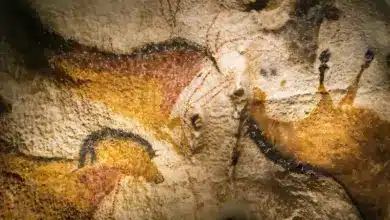The Earliest Wildlife Art
Cave Paintings, And What They Mean To Us
It was not that long ago that wildlife meant everything to mankind. All humans sustained themselves by hunting animals, catching fish and gathering edible plants that grew naturally. For a lot of groups, when herds of wild game moved, it was necessary to move with them to avoid starvation. In fact, according to one widely accepted theory, humans were drawn out of Africa to populate the rest of the world by migrating herds of big game.
It stands to reason, then, that something so central to our survival as wild animals would come to preoccupy much of our developing capacity for thought as well as to dominate our blossoming spiritual lives. In fact, even though much of humankind switched over to agriculture and a sedentary lifestyle many thousands of years ago, the visible proof for this supposition remains behind in caves and on the rock walls of sheltered cliffs the world over.
Much of the world’s earliest art depicts drawings and paintings of animals—many now long extinct—that we humans hoped—perhaps even prayed—would sustain us and keep us from hunger and cold. This wildlife art can be found almost everywhere that early humans traveled, from the cliff faces of the American West to the rocky outcroppings of Australia.
Some of the most accomplished artists were the stone-age Europeans known as Cro-Magnons, who were the direct ancestors of today’s European peoples. Painting on the dark walls of caves, these artists created a highly detailed and extremely accurate pictorial record of the wildlife with which they found themselves surrounded. The damp conditions inside the caves did such a good job of preservation that many of these cave paintings look just as fresh today as they did the day—15- to 30,000 years ago—when they were first brought to vibrant life. Wild animals depicted in the lifelike paintings include horses, bears, European bison—now almost extinct—aurochs (the much larger ancestor of the modern bovine; now extinct); deer and even the extinct woolly rhinoceros.
Three of the most famous caves are Lascaux and Chauvet in southern France, and Altamira, in Spain. The picture above is one of the most famous of all the many Altamira paintings. Lascaux was discovered by a pair of French teenagers in 1940; its 2,000 paintings are estimated to be over 17,000 years old. Chauvet, not discovered until 1994 contains the most ancent Paleolithic art, estimated at over 30,000 years old. The paintings at Altamira in Spain, mostly of bison, are thought to be 20,000 years old. The cave was discovered in the late 1800’s.
The early European artists created their cave paintings using charcoal and a variety of pigments found in the natural environment such as ochres (red and yellow), hematite and manganese oxide.
If you’d like to take a very impressive virtual tour of the cave at Lascaux, click here. And if you’d like to see a gallery cave paintings from a variety of European locations—unlabeled, unfortunately, but still beautiful—click here.
Cave art serves to remind us that there once was a time when we were at the mercy of wildlife, and not the other way around. The thought makes a wildlife appreciator feel wistful.

